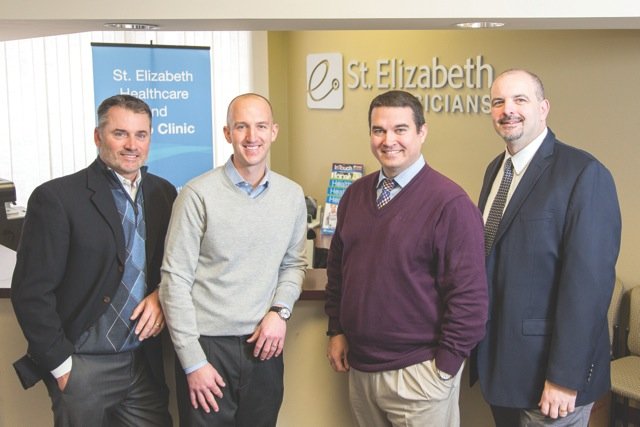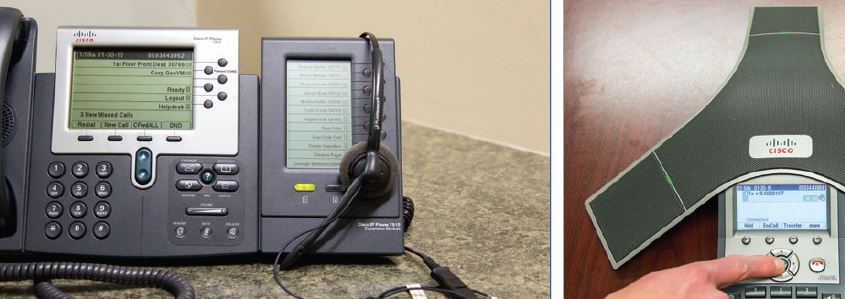Just What the Doctor Ordered
As published in the Winter 2015 issue of LEAD Magazine
It sounds like an advanced level MBA exam prompt. You need to merge more than 82 locations, more than 1200 professionals and multiple telephone systems. You need to securely route all communications, and create an efficient, cost-effective system with advanced call management, real-time dashboards and redundancies to make sure your voice and data systems don’t go down. You need to do all this on-time and on-budget.
This is exactly the situation that St. Elizabeth Physicians (SEP) was facing during a period of tremendous growth. With more than 330 physicians and more than 82 locations, this prompt became a reality. Offices that needed to work together often had disparate systems. What was the answer? Call in the experts.
SEP turned to Mason-based Advanced Technology Consulting (ATC), a leading telecom consulting firm, to help them evaluate their options.
The objective was to identify and implement a corporate Unified Communications (UC) solution that met the current and future needs of a growing healthcare organization in a constantly changing medical landscape.
The result? Working with telephony provider West IP Communications to implement a cloud-based, hosted Voice over IP (VoIP) system complete with a suite of on-demand services, thereby complementing SEP’s status as an industry leader serving the Tri-state with patient-centered healthcare.
“Over the last five years, we have brought together about 32 different private practices as part of St. Elizabeth Physicians,” explains SEP Senior VP and Chief Operating Officer Jacob Bast, “and we inherited a number of different legacy phone systems. When we decided to move to a new system, we had about seven different systems, none of which operated the way we needed.”
The St. Elizabeth Physicians’ administrative team knew it needed to bring in outside expertise to make sure the best possible system was put into place.
“It’s difficult for an organization whose main focus is not telecommunications to have the internal expertise to vet all the options available in such a competitive environment,” says Bast. “You can’t just open up a commercial vendor web site and say, this vendor is best for us. It is so contingent upon your own existing technologies, and your own human resources to manage the technologies. So much individual criteria goes into the right vendor and right technology… having someone to help you wade through the process is really important.”
Bast and SEP not only appreciated ATC’s evaluation and counsel, but also the consultants’ experiences with the different providers. “ATC knowing the providers’ service history, their ability to grow and flex with our needs, was invaluable in our selection process.”
ATC conducted a complete telecom audit, visiting every SEP site, reviewing every contract. ATC examined all relevant aspects—lines, cabling, handsets, local and long distance service, Internet service and more.
They performed a thorough business-needs analysis including surveying SEP’s 1,200 employees regard-ing the existing phone system, future requirements and desires.
“After they finished their review and analysis,” says Bast, “ATC brought in several different, vetted vendors. Our selection criteria included scalability and flexibility of the system. SEP is a rapidly growing organization. Having a system that can grow with us is very important.”
UCaaS for Scalability and Optimized Care
West IP Communications fit the bill. West IP is the recognized leader in Unified Communications as a Service (UCaaS), according to Gartner’s 2014 Magic Quadrant. Its UCaaS solution is delivered on a Cisco hosted collaboration platform layered with additional custom capabilities built in by West IP.
“West is committed to providing our clients with the industry’s top UCaaS options,” says Senior Vice President of Technology and Operational Services at West IP Communications Randy McGraw. “We’re proud to demonstrate our on-going mastery of Cisco solutions.”
West IP’s Director of Product Development, Marcus Schmidt, explains how it works. “Cisco’s platform supports cloud-based services for its UC manager, voicemail system and the unified presence application.” West IP then “layers additional components, such as a unified portal where customers can manage users, their permissions, their security, and jump into the other Cisco features and functions while also managing the core West IP functions.”
Instead of having these systems and solutions deployed “on-premise” for a customer at the customer’s location, the services are cloud-based. “We work really closely with Cisco and have incorporated that product portfolio into our broader portfolio of VoiceMaxx products,” says Schmidt.
So, Cisco’s hosted collaboration solution is essentially a starting point that West IP builds on to deliver the best results to St. Elizabeth Physicians and other clients. And, with communications as sensitive as healthcare, is this system secure? Extremely.
West IP utilizes MPLS – multi-protocol label switching – and other technologies to make sure the connections are private, secure and optimized, with higher-reliability than traditional communication systems.
Moreover, with cloud-based phone systems, a separate phone system is not required for each and every office location. Because hardly any actual on-premise hardware is required for UCaaS, SEP can expand to new locations, easily and cost-effectively without worrying about compromising its systems or security.
A recovery strategy leverages multiple servers in multiple states to deliver geographic redundancy and maxi-mum up-time for situations where an unforeseen, system-debilitating event occurs. Each SEP office has a recovery mode that redirects calls to another office. The receiving office is notified in advance. If the second office goes down, an answering service is deployed with access to doctors on call.
What does the new UCaaS system mean in practice for St. Elizabeth Physicians, partners and patients?
“We are thrilled with the results,” says Bast. “In any sort of large implementation there are lessons we learn, but this transition has provided so many wonderful benefits. We are all on the same phone system. Training and orientation of staff is very easy with this unified system. We can connect our offices more effectively. If we have a single office with a physical cut in the line or another is-sue, another one of our offices can immediately recover their system and begin answering calls for that office. Service does not go down for our patients. If our patient calls an office and for some reason the phone service is out, the call will still be answered by another office and the patient won’t even notice.”
The implications for customer service are positive. Patients are still able to get answers, make appointments and conduct business.
Your Health Line and Telemedicine
In fact, with SEP’s “Your Health Line,” getting connected is easier than ever for patients.
Your Health Line makes it simple for patients to find a provider, office or department.
“There is no way we could have offered that previously,” says Bast. “Using a unified phone system and unified electronic medical record access, we are able to have a central phone center with scheduling for all offices. If a patient needs to establish with a new physician, or is new to town, call center employees can make a recommendation about which physician would be best for that patient, someone close to work or home, or take into consideration gender or specialty preferences. Those associates can view all our offices and have information about all our providers. This is extremely helpful in aiding the patient in selecting the physician best for them.”
And if the patient is disconnected?
If a caller disconnects before reaching the office staff, those “abandoned calls” are now able to be identified by associates in the office. “In the rare circumstances where a patient calls and for whatever reason has decided not to wait or disconnects, we can call back via an outbound call,” says Bast. “Not only is that a nice service, but it has come as a surprise to many of our patients that we will reach out to them to address their needs.”
Another way the new UCaaS system is benefiting patients? Their pocketbooks. “Service and operational aspects make our lives easier, but let’s not discount operational efficiencies in the healthcare environment,” emphasizes Bast. “Healthcare costs are top of mind. Any-thing we can do to reduce operational costs are savings that can be passed along to the consumer, making things better for them while positioning us to be more competitive in a growth market.”
With the partnership between SEP, ATC and West IP, there are more technology advances on the horizon.
“The capabilities put in place are a starting point to do more unified communications in the future,” says Schmidt. “For instance, if St. Elizabeth Physicians wants to do more video conferencing, or do more with mobile devices, having all this in place is the foundation that lets them move into additional directions if they choose. The technology is there, the tools are there. In the future, it’s possible there will be additional implementation of ‘telemedicine,’ where you take video and start using it for things like having an expert in a metro area consult a doctor in a rural area, or a patient can start a chat with a nurse and then step beyond that with a voice or video conversation.”
It’s all about extending the footprint and extending customer service beyond coming into the office or pick-ing up the phone,” he adds. “It’s richer interaction with video consultation.”
Bast agrees. “We have been first in the region to introduce e-visits and video visits with our patients. Patients can sit in their living room and conduct a healthcare visit through electronic or video communications. Eventually, more patients will benefit from this type of service. It is a means to provide care in a way that is less costly than traditional care, as well as access and convenience. From their own office, home or even their own car, nearly 24 hours a day, seven days a week.”
Just as patients can rely on SEP at any time, SEP can rely on ATC. “I can’t place a value on the assistance we receive from ATC’s Nick Enger,” says Bast. “We look at him as an extension of our IT team and an adopted member of the SEP family. His telecommunications expertise and guidance have proven to be very valuable to us. We also see David Goodwin (Managing Partner) at various go-lives and meetings, as well as bi-annual telecom re-views with our executive staff.”











